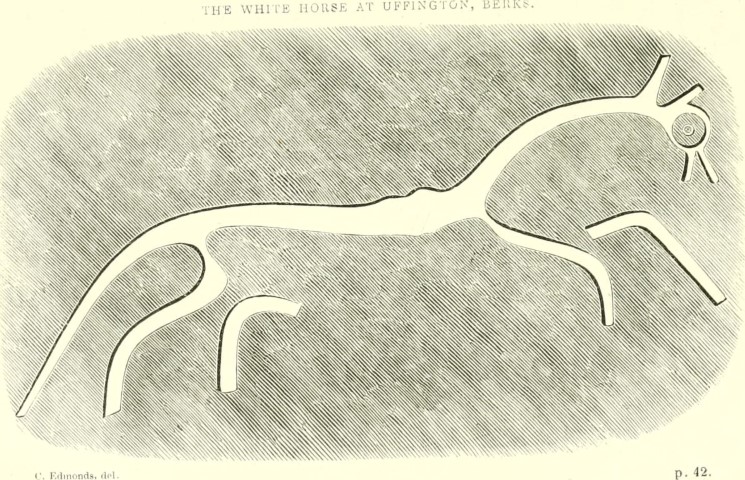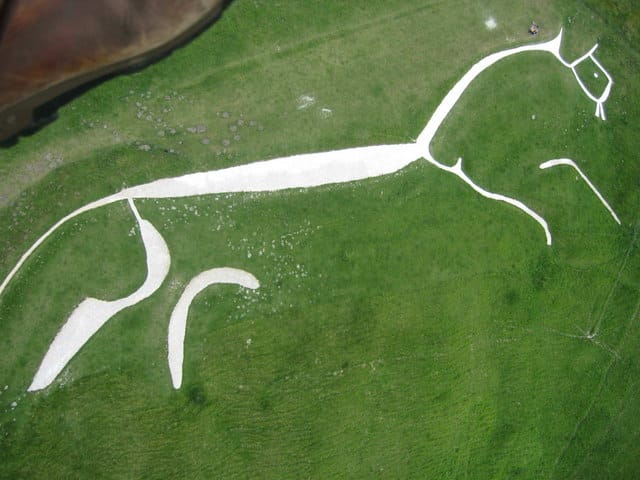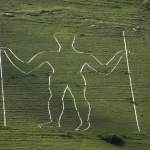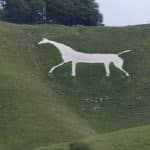Last Updated on 20/03/2023 by Alex Hamlyn
Table of Contents
The Uffington White Horse is a prehistoric hill figure located in the English county of Oxfordshire. The figure, which is cut into the chalk of the hillside, depicts a horse and is thought to date back to the late Bronze Age or early Iron Age. The figure is approximately 110 meters long and has been dated to around 3,000 BC.
The Uffington White Horse is one of the oldest known examples of a hill figure in Britain, and is thought to have had religious or ceremonial significance to the people who created it. The figure is considered to be a Scheduled Ancient Monument and is protected by law.
Where is the Uffington White Horse?
What is the significance of the Uffington White Horse?
The significance of the Uffington White Horse is not entirely clear, as the people who created it left no written records. However, it is believed that the figure held religious or ceremonial significance for the ancient people who created it. Some experts suggest that the horse was associated with a specific god or goddess, and was used in religious rituals or ceremonies. Others propose that it may have been a symbol of a tribe or community, and was used to mark their territory.
Some experts have also suggested that the Uffington White Horse may have been used as a marker or landmark, helping people to navigate the landscape or to mark important locations, such as burial sites.
It’s also worth noting that the Uffington White Horse is located on the Ridgeway, an ancient road that runs through the county, which was an important route for trade and communication in prehistoric and ancient times, so it could also have been a marker for travelers.
The real significance of the Uffington White Horse and many other ancient figures like it remains a mystery, as the people who created them left no written records, and the meaning and purpose of these figures can only be inferred from the context and the materials they were made of, and the location where they were placed.
How was the Uffington White Horse made?
The exact method used to create the Uffington White Horse is not known, as the people who made it left no records. However, it is believed that the figure was created by carving into the chalk hillside using simple tools, such as antler picks. The figure would have been created by removing the top layer of grass and soil to reveal the white chalk beneath. This process would have been repeated until the desired shape was achieved. The horse figure was then maintained over time, by periodically removing the overgrowth of grass and weeds that would otherwise obscure the image, allowing it to remain visible.
The age of the horse is uncertain and there is ongoing debate among scholars about how it was made, some suggest it could have been made by cutting the turf and scraping the soil to reveal the white chalk beneath while others suggest it could have been made by scooping out the chalk to reveal the darker subsoil beneath.
How far does the chalk layer extend from Britain?
The chalk layer, also known as the Chalk Group, extends from Britain and is found in several other countries, including France, Belgium, the Netherlands, Germany, Denmark, and parts of northern Europe. The Chalk Group is a layer of sedimentary rock that was formed from the accumulation of the remains of microscopic marine organisms and is composed primarily of calcium carbonate.
In Britain, the Chalk Group is found across large parts of the southern and eastern regions, including the South Downs, the North Downs, and the Chiltern Hills. The Chalk Group is also found in other parts of Europe, including the Paris Basin in France and the North German Plain in Germany, where it is often associated with similar landscapes and geomorphological features.
The thickness of the chalk layer can vary widely depending on the location, but in some areas it can be more than 600 meters thick. The chalk layer is an important resource for a variety of industries, including agriculture, where it is used as a source of lime for fertilizers, and for the production of cement, building materials, and other products.
The chalk layer is a widespread geological feature that extends across much of northern Europe and is an important resource for a variety of industries and activities.
Are there other chalk figures like the Uffington White Horse in Oxfordshire?
There are several other chalk figures located in Oxfordshire, England. Some examples include:
- The Dragon Hill: is an artificially flattened hilltop near Uffington and is associated with the nearby Uffington White Horse and believed to have been used for rituals.
- The Ridgeway: is an ancient road that runs through the county and is home to several other chalk figures, including the Barbury Castle horse and the Pewsey horse.
- The Marlborough White Horse: located near the town of Marlborough, is a relatively recent addition to the county’s collection of hill figures, having been created in 1804.
Many of these figures are hard to spot, as they are not always well-preserved and some are quite faint, and can be hard to spot if they are not maintained regularly.

Are there chalk figures like the Uffington White Horse elsewhere in the world?
There are similar chalk figures found around the world although they are not as well-known or as well-preserved as those found in Britain.
For example, there are several similar chalk figures located in Germany, including the Chalk Horse of Hanover, which is similar in style to the Uffington White Horse. In South America, there are several figures known as “geoglyphs” that have been created by ancient cultures, including the Nazca Lines in Peru, which are thought to date back to around 500 AD and depict a variety of figures, including animals and people.
There are similar chalk figures located in other parts of Europe, such as France and Italy, and in Australia, where there are several figures known as “Bradshaws” that are thought to have been created by indigenous cultures.
Chalk figures like those found in Britain are relatively rare, and it’s likely that many have been lost or destroyed over time due to natural erosion and human activity. However, those that survive are considered to be important cultural and historical landmarks that provide valuable insights into the beliefs and practices of ancient cultures.
What is the oldest chalk figure in the UK?
The oldest known chalk figure in the UK is the Cerne Abbas Giant, which is located in the county of Dorset, England. The Cerne Abbas Giant is a large hill figure that depicts a naked man holding a club and is thought to date back to the late Iron Age or early Roman period, around 2,000 years ago.
Like the Uffington White Horse, the Cerne Abbas Giant is cut into the chalk hillside and is thought to have had religious or ceremonial significance to the people who created it. The giant is approximately 180 feet tall and is one of the largest hill figures in Britain.
The age of the Cerne Abbas Giant, like other hill figures, is uncertain and is based on limited evidence, such as the style of the figure, the materials used to create it, and its location and context.
What is the oldest document to mention the Uffington White Horse?
The Uffington White Horse is mentioned in several historical documents, but the oldest known written reference to the figure comes from a poem called “The Battle of Brunanburh” which was composed in the 10th century, in Anglo-Saxon England. The poem describes a battle that took place in 937 AD, and mentions the “White Horse Hill” as a landmark in the area.
The poem is not a contemporary account of the Uffington White Horse and it’s not clear if the reference to the White Horse Hill is related to the Uffington White Horse. The poem is also a literary work, not a historical document and the mention of the White Horse Hill might be a metaphor or a reference to a different horse.
The Uffington White Horse has also been recorded in other historical documents, such as the Domesday Book, which was compiled in the 11th century and lists the lands and assets of England. The Domesday Book mentions a “White Horse” in the area of Uffington. There are also references to the horse in 18th and 19th century maps and drawings, which were created by local antiquarians and historians, which are considered as more reliable historical documents.
How are chalk figures like the Uffington White Horse discovered if they are hard to see?
The chalk figures in Oxfordshire, including the Uffington White Horse, were likely discovered by people living in the area or by travelers passing through. These figures have been known for centuries, and have been recorded in historical documents, such as maps and drawings, and in local folklore.
Many of these figures have been studied and researched by archaeologists, historians, and other experts who have used a variety of methods to uncover more information about them. Some have used aerial photography to study the figures and their surrounding landscape, while others have used carbon dating to determine their age.
Many of these figures were likely easier to see in the past, as they would have been more distinct and visible when they were first created. Over time, however, they have become less distinct as vegetation has grown over them and as they’ve weathered and eroded.
These figures were created in places that were easily visible and accessible, such as hilltops, and would have been visible to people traveling through the area, which may have helped to ensure their discovery and preservation.
Does the Uffington White Horse have any religious significance?
This is not entirely clear, as the people who created it left no written records. However, it is believed that the figure held religious or ceremonial significance for the ancient people who created it. Some experts suggest that the horse was associated with a specific god or goddess, and was used in religious rituals or ceremonies. Others propose that it may have been a symbol of a tribe or community, and was used to mark their territory.
It’s also worth noting that the Uffington White Horse is located near the Uffington Castle, an Iron Age hill fort, and the Wayland’s Smithy, a Neolithic chambered tomb, and it’s possible that it was associated with rituals, ceremonies, and burials that predates the arrival of Christianity in Britain.
The exact religious meaning of the Uffington White Horse is not known, and it is likely that the figure had multiple meanings and functions for the people who created it, including religious, ceremonial, territorial, and navigational purposes.
The fact remains that the Uffington White Horse is a valuable cultural and historical artifact that provides valuable insights into the beliefs and practices of ancient cultures, although its exact religious meaning remains a mystery.
Is the Uffington White Horse connected to pagan beliefs?
The Uffington White Horse is believed to have been created by the pagan Anglo-Saxons, who lived in the area before they converted to Christianity in the 7th century. It is likely that the horse held religious or ceremonial significance for the pagan Anglo-Saxons, although the exact religious meaning of the figure is not entirely clear.
Some experts suggest that the horse was associated with a specific pagan deity, such as the goddess Epona, who was associated with horses and fertility in ancient cultures. Others propose that the horse was a symbol of a tribe or community, and was used to mark their territory.
The Uffington White Horse is considered to be a pagan artifact, and provides valuable insights into the beliefs and practices of the pagan Anglo-Saxons and other ancient cultures in the area. However, the exact religious meaning of the figure remains a mystery.
Is the Uffington White Horse connected to the spread of Christianity in Britain?
There is no direct evidence to suggest that the Uffington White Horse has any connection to the spread of Christianity in Britain. However, it’s worth noting that the white horse is located in an area that was occupied by the Anglo-Saxons, who were pagans before they converted to Christianity in the 7th century.
It’s possible that the Uffington White Horse was created by the pagan Anglo-Saxons and it’s not clear how it would have been treated by the Christian Anglo-Saxons after their conversion, some experts suggest that the horse might have been destroyed or modified by the Christian Anglo-Saxons, while others propose that it might have been left untouched as a cultural heritage or even considered as a Christian symbol, but there is no clear evidence to support any of these hypotheses.
The spread of Christianity in Britain was a gradual process, and it’s likely that many pagan symbols and practices continued to be used for some time after the conversion. Many churches and monasteries were built on the sites of ancient pagan temples and shrines, and it’s possible that some elements of paganism were incorporated into Christian practices.
There is no clear evidence of any connection between the Uffington White Horse and the spread of Christianity in Britain, but it’s possible that the horse has undergone changes or shifts in meaning over time due to cultural and religious changes in the area.
Does the Uffington White Horse have any unique features compared to other chalk figures?
The Uffington White Horse is considered to be a unique and distinctive chalk figure for several reasons:
- Age: The Uffington White Horse is one of the oldest chalk figures in Britain and is thought to date back over 3,000 years, making it an important historical artifact.
- Style: The Uffington White Horse is depicted as a stylized horse, with a curving body, raised tail, and elongated legs. This style is distinct from other chalk figures in Britain, which are often depicted as more realistic horses or other figures.
- Location: The Uffington White Horse is located on the White Horse Hill, a prominent hilltop in the Oxfordshire countryside, which provides an excellent view of the surrounding landscape. This location is also near other important cultural and historical sites, such as the Uffington Castle hill fort and the Wayland’s Smithy long barrow.
- Size: The Uffington White Horse is approximately 374 feet long, making it one of the largest chalk figures in Britain.
- Preservation: The Uffington White Horse is well-preserved, and has been protected and maintained for over a thousand years, making it one of the best-preserved chalk figures in Britain.
The Uffington White Horse is considered to be a unique and distinctive chalk figure, and is an important cultural and historical landmark that provides valuable insights into the beliefs and practices of ancient cultures.
Are there burial mounds nearby the Uffington White Horse?
There are several burial mounds located near the Uffington White Horse. The most notable of these is the Uffington Castle, an Iron Age hill fort that is located on the same hill as the white horse. The fort is surrounded by a ditch and bank, and the interior is home to several burial mounds, which may have been used to bury important members of the community.
Additionally, there are several other burial mounds located in the surrounding area, including the Wayland’s Smithy long barrow, which is located about 3 miles from the Uffington White Horse and is a Neolithic chambered tomb. The barrow is one of several located along the Ridgeway, an ancient road that runs near the Uffington White Horse.
It’s worth noting that many of the burial mounds in the area have been excavated, revealing artifacts and human remains that have provided valuable insights into the lives and beliefs of the people who lived in the area during the prehistoric and ancient period.
It’s also worth noting that the Uffington White Horse is located near the Dragon Hill, an artificially flattened hilltop which is associated with the nearby Uffington White Horse and believed to have been used for rituals and ceremonies. The Dragon Hill is also considered as a possible location of a burial site.
Have any hauntings been reported near the Uffington White Horse?
Many ancient and historic sites, including burial mounds and hillforts, are often associated with legends of ghosts and spirits. These legends can be rooted in the folklore and myths that have developed around these sites over time, and in the idea that ancient people believed in the afterlife and the possibility of the dead returning to the world of the living.
Many ancient and historic sites, like the Uffington White Horse and the nearby burial mounds, have been associated with rituals, ceremonies and burials, which can add to the idea that these sites might be haunted.
Is the Uffington White Horse still maintained today?
The Uffington White Horse is still maintained today and is considered an important cultural and historical landmark in Britain. The figure is maintained by the National Trust, a UK charity that manages historic sites and landscapes, and local volunteers.
The maintenance of the Uffington White Horse involves regular cleaning and restoration of the figure, as well as management of the surrounding area to prevent erosion and damage. The figure is also protected by law, and is designated as a Scheduled Ancient Monument, which means that it is protected by law from unauthorized alteration or destruction.
Today the National Trust works with local communities and volunteers to maintain the site and to promote understanding and appreciation of the Uffington White Horse and its cultural and historical significance.
The Uffington White Horse is considered an important cultural and historical artifact, and it is well-maintained and protected to ensure its preservation for future generations.
Uffington White Horse Image Credits
- Aerial photograph by Dave Price, used under a Creative Commons licence.
References
- https://en.wikipedia.org/wiki/Uffington_White_Horse
- https://www.nationaltrust.org.uk/visit/oxfordshire-buckinghamshire-berkshire/white-horse-hill
- https://www.english-heritage.org.uk/visit/places/uffington-castle-white-horse-and-dragon-hill/
- https://www.smithsonianmag.com/history/3000-year-old-uffington-horse-looms-over-english-countryside-180963968/



